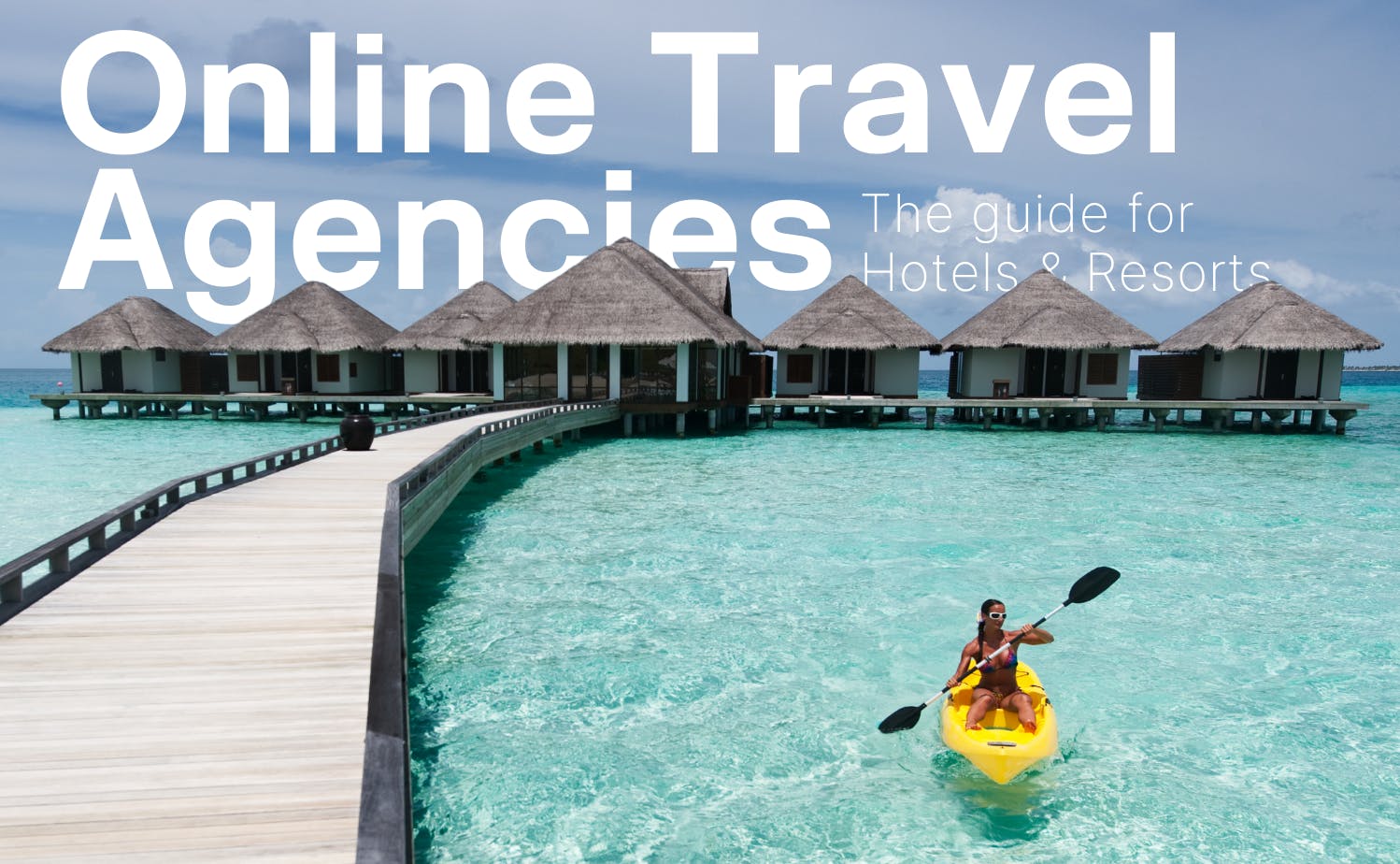
Online Travel Agencies (OTAs): The Guide for Hotels & Resorts

This guide explores how hotel brands can harness OTAs to boost visibility, optimize distribution strategies, and balance OTA bookings with direct reservations to maximize profitability.
In today’s interconnected travel ecosystem, Online Travel Agencies (OTAs) are indispensable tools for hotels and resorts to connect with global travelers. For larger hotel brands, navigating the complex world of OTAs requires strategic planning and robust multi-channel management to unlock their full potential.
This guide explores how hotel brands can harness OTAs to boost visibility, optimize distribution strategies, and balance OTA bookings with direct reservations to maximize profitability.
What Are OTAs and Why Are They Important?
Understanding OTAs
Online Travel Agencies are platforms that aggregate and showcase accommodations, flights, and other travel services. Examples include Booking.com, Expedia, and Agoda. They simplify the booking process by allowing travelers to compare prices, amenities, and reviews in one place.
For hotels, OTAs are valuable marketing and distribution partners that provide access to a global audience, driving bookings that might otherwise be hard to achieve through direct efforts alone.
The Importance of OTAs for Hotels
OTAs dominate the online travel market, accounting for a large share of bookings. Their extensive advertising budgets, user-friendly interfaces, and loyalty programs attract millions of travelers, making them vital for increasing visibility and occupancy rates.
For large hotel brands, OTAs offer:
- Access to New Markets: Tap into international travelers and niche audiences.
- Demand Generation: Increase occupancy during low seasons or in underperforming regions.
- Brand Awareness: Act as a billboard for your property, attracting travelers who might later book directly.
Challenges in Working with OTAs
While OTAs offer clear benefits, there are challenges:
- High Commission Fees: Typically 15-20%, which can impact profitability.
- Over-Reliance Risk: Excessive dependence on OTAs can dilute brand identity and reduce direct bookings.
Complexity of Multi-Channel Management: Coordinating rates, inventory, and content across platforms is challenging without the right tools.
Multi-Channel Management for Hotel Brands
What Is Multi-Channel Management?
Multi-channel management involves overseeing your hotel’s presence across various OTAs, metasearch platforms, and direct booking channels. For large brands managing multiple properties, it’s essential to maintain consistency and avoid discrepancies in rates, availability, and branding.
Benefits of Multi-Channel Optimization
- Maximize Revenue Streams: Reach diverse customer segments through different platforms.
- Prevent Overbookings: Streamline inventory management with synchronized updates across channels.
- Enhance Guest Experience: Provide accurate information and seamless booking experiences.
Common Pitfalls
- Rate Disparities: Offering different prices on OTAs and direct channels can confuse travelers and hurt brand trust.
- Inventory Mismanagement: Overselling rooms due to unsynchronized updates leads to unhappy guests.
- Underutilized Tools: Without a channel manager or revenue management system, managing multiple OTAs becomes inefficient.

Best Practices for Optimizing OTA Partnerships
1. Select OTAs Strategically
Larger hotel brands should diversify their presence across platforms to maximize reach.
- Global OTAs: Use major players like Expedia for broad appeal.
- Niche Platforms: Target specific markets, such as luxury travelers (Mr & Mrs Smith) or last-minute bookers (HotelTonight).
- Regional OTAs: Partner with platforms like Ctrip for the Chinese market or Wotif for Australia.
2. Maintain Rate Parity
Rate parity ensures that your prices are consistent across all channels, including OTAs and direct bookings. This builds trust with travelers and prevents platform penalties for discrepancies.
- Dynamic Pricing: Use revenue management tools to adjust rates based on demand and market conditions while maintaining parity.
3. Optimize OTA Listings
Your OTA profile acts as the digital storefront for your hotel.
- High-Quality Visuals: Good visuals increase conversion by 30%. Invest in professional photography to showcase your property’s unique features and ensure you have an AI moderation software to ensure the quality of your images across all OTAs.
- Detailed Descriptions: Include information about amenities, nearby attractions, and unique selling points.
- Guest Reviews: Actively solicit and respond to reviews to improve your ranking and visibility on OTA platforms.
4. Leverage the Billboard Effect
The billboard effect refers to the phenomenon where travelers discover your property on an OTA but complete their booking on your direct website.
- Use OTAs to drive traffic to your website by maintaining consistency in branding and offers.
- Provide incentives, such as exclusive deals or loyalty points, to encourage direct bookings.
5. Use Data to Drive Decisions
OTAs provide valuable insights into traveler behavior, preferences, and market trends.
- Analyze Booking Patterns: Identify peak seasons, popular room types, and traveler demographics.
- Adjust Strategies: Use this data to fine-tune promotions, pricing, and marketing campaigns.
How Technology Simplifies OTA Management
For larger hotel brands, managing OTAs without the right technology can be overwhelming. Key tools include:
1. Channel Managers
Channel managers automate the distribution of inventory and rates across OTAs, metasearch engines, and direct booking platforms.
- Real-Time Updates: Prevent overbookings and ensure accurate inventory.
- Centralized Management: Reduce manual effort and errors by managing all channels from one interface.
2. Property Management Systems (PMS)
A robust PMS integrates with channel managers and revenue management systems, providing a single source of truth for room availability and rates.
3. Revenue Management Systems (RMS)
RMS tools use data analytics to optimize pricing strategies.
- Forecast Demand: Predict high and low booking periods.
- Adjust Rates Dynamically: Maximize revenue by adapting prices to market conditions.
4. CRM and Data Platforms
Use customer relationship management (CRM) systems to analyze guest data and create personalized marketing campaigns. This ensures that your direct channels complement OTA efforts effectively.
Balancing OTA and Direct Bookings
While OTAs are essential, direct bookings are more profitable. Here’s how to strike the right balance:
1. Enhance Your Website Experience
- Mobile-Friendly Design: Ensure your booking engine is optimized for mobile users.
- Clear CTAs: Use compelling calls-to-action to guide users toward completing a reservation.
- Exclusive Offers: Provide deals that are only available on your website.
2. Strengthen Your Brand Identity
OTAs often showcase multiple hotels in one search, making it easy for your property to blend into the crowd. Strengthen your unique value proposition by emphasizing:
- Sustainability Efforts: Highlight eco-friendly practices to attract conscious travelers.
- Personalized Service: Promote offerings like tailored concierge services or unique in-room experiences.
3. Engage with Loyalty Programs
Develop loyalty programs that reward repeat bookings through direct channels. Combine this with marketing campaigns that encourage sign-ups via email or social media.

Advanced Strategies for Larger Hotel Brands
1. Invest in Paid Advertising on OTAs
Most OTAs offer pay-per-click (PPC) advertising options to boost visibility. For larger brands, this can be an effective way to dominate search results during peak booking periods.
2. Expand into Emerging Markets
Identify underserved regions or demographics and partner with OTAs specializing in those markets. For example, targeting travelers from India or the Middle East can open new revenue streams.
3. Monitor Competitors
Use competitive analysis tools to track how your competitors perform on OTAs. Adjust your pricing, promotions, and marketing strategies accordingly.
Key Takeaways for Maximizing OTA Partnerships
- Diversify Your Channel Mix: Collaborate with global, regional, and niche OTAs for maximum reach.
- Prioritize Technology: Invest in channel managers, PMS, and RMS tools for seamless operations.
- Focus on Data: Use insights to refine strategies and deliver personalized guest experiences.
- Balance OTA and Direct Bookings: Strengthen your direct channels while leveraging OTAs for visibility.
By adopting these strategies, large hotel brands can turn OTAs into powerful allies in their distribution strategy. Multi-channel management is no longer just a logistical necessity—it’s a pathway to sustained growth in an increasingly competitive hospitality landscape.
Increase OTA Booking Conversion with OCUS
In a digital landscape driven by imagery, visuals play a crucial role in driving OTA conversions. High-quality, optimized images create engaging listings that capture travelers’ attention and inspire confidence.
This is where OCUS excels as a one-stop-shop for managing visual performance at scale. Through its global network of 35,000+ professional photographers, OCUS ensures your listings are supported by captivating imagery that aligns with your brand standards. Its AI-driven solutions handle image moderation, enhancement, and optimization, freeing your team to focus on other priorities.